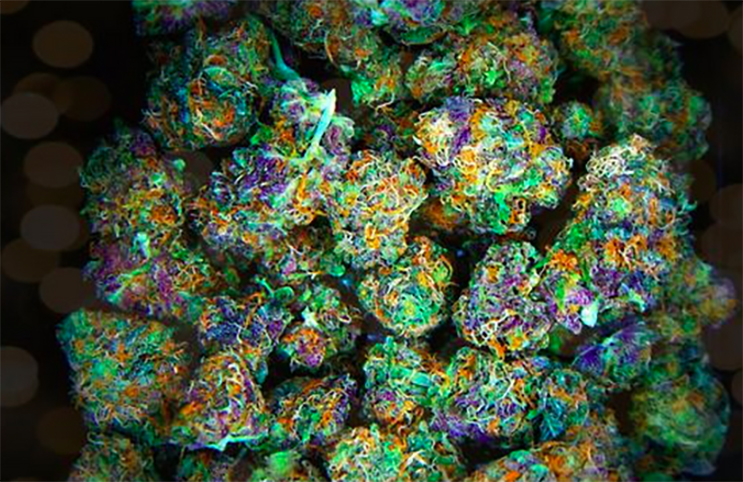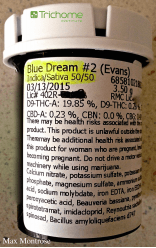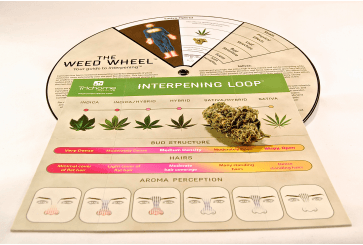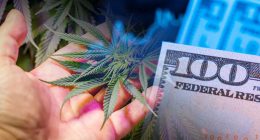Strain names, my favorite topic. It’s one of those hot debates that seem to never go away in the world of weed. Most people don’t have a clue about this genetic and economic quagmire. There’s a good chance what you think you bought from a dealer or dispensary isn’t legit. Sometimes you do buy truthful genetics and we will cover that. But more often than not, your Girl Scout Cookies may be a rookie’s first grow from some craigslist swap. So that things don’t get too sticky, let’s break this bad boy down one step at a time. We’ll start from the top, with the science.
The Science
There are arguably three species or subspecies of cannabaceae-cannabis that include sativa, indica, and ruderalis. Due to 80 years of government restrictions on cannabis research; cannabis linage and genetics have been an ongoing debate for decades. Now that we have been given a little slack, researchers like those at the Cannabis Genomic Research Initiative at Colorado State University are mapping the global genomes of cannabis variety types. At the same time, some other operations across the country, are starting to fingerprint the terpene profiles of cannabis. Scientifically speaking, terpenes are evaporating molecular hydrocarbon chains that produce
Scientifically speaking, terpenes are evaporating molecular hydrocarbon chains that produce smell. Research like this will inevitably help limit the never-ending strain name dilemma. One thing is for sure, science agrees there is a strain name problem as suggested by the scientific article, The Genetic Structure of Marijuana and Hemp; “We find a moderate correlation between the genetic structure of marijuana strains and their reported C. sativa and C. indica ancestry and show that marijuana strain names often do not reflect a meaningful genetic identity”. But where did it all start? Let’s talk about the history.
Copyright 2015: The Trichome Institute LLC, All Rights Reserved.
The History
Back when American soldiers were in Nam, four finger lids, sticks and beans existed in hippy sacs. There wasn’t a strain name dilemma at all. From the late 50’s to the late 70’s, the name that accompanied a type of cannabis was usually its place of origin. “Its called Thai Stick.. My brother brought it back from the war dude, it’s some heavy shit.” Thai Stick is from Thailand but apparently distributed around South East Asia. Acapulco Gold is from Acapulco Mexico, Durban Poison is from Durban South Africa, Afghani Kush from the Hindu Kush mountains of Afghanistan, Panama Red from Panama, and so on.
Back then Americans didn’t cross strains. Some smoked feral ditch weed and Shwag very low in THC and thus not that potent. Apart from C-grade shwag shipments from cartels in Mexico, the chronic Americans accessed was imported from other countries around the world. Thanks to the War on Drugs; Cheap, organic, and relatively safe weed bloomed into a billion dollar black market offering both exquisite craft ganja and disgusting harmful pot.
Thank you, Nixon administration, for helping the world develop such a sophisticated dankness market! After the Controlled Substances Act of 1972, cannabis enthusiasts retreated to their basements and mountain hideouts to grow in secret. Cannabis is still more federally illegal than cocaine and meth. But I digress… in the mid 70’s, Berkeley students traveled to Afghanistan strain hunting for the type of cannabis Afghans used for their famous Hashish. They brought seeds back from Afghanistan and grew them at a similar latitude and longitude in northern California. The Afghan strains thrived in the emerald triangle, and many other strains did too.
Around the mid 70’s, growers started breeding more potent strains with large fluffy buds. The goal was to produce the most potent product possible while maximizing quantity per harvest. After many hybridizations (and ounces smoked) they had created a whole wave of new strains, and all these new babies needed names. Strains named after their scent are hard to argue with. Grapefruit Haze, Lemon Diesel, Skunk 1, Blueberry, Grape Ape, Strawberry Cough. These strains are named after their terpene profiles (smells). These terpenes are chemically the same in the fruit and other natural/non-natural things these smells derive from.
Copyright 2015: The Trichome Institute LLC, All Rights Reserved.
Outside of strains named after smells, there were a handful of black-market growers producing high quality genetics with specialized branding. Train Wreck, Northern Lights, Master Kush, Bruce Banner, and AK-47, to name a few. These became the legends of the next age; strains that could make any stoner go slack jawed instantly.
The Wild West of Weed
Before the dispensary circus of ‘09 in Colorado, black-market growers, and dealers were coming up with strain names as fast as they could counterfeit big-name brands. Your dealer would explain to you the amazingness of his primo dankness through the strain name, because most dealers aren’t sophisticated enough to go into further details. Mr. Dealer might ask you, “You know AK-47 homie? Well this shit is AK-48! What do you know about weed a step better than the best?” Yes there is really a strain called AK-48. Kat Williams made fun of the name bragging game during one of his skits: “This shit right here. This-this shit right here nigga, this is kripta chrona-canalike! And every 2 weeks the shit gets stronger and stronger.” Every dealer wants you to think their weed is better so you buy their product and not the next guys.
I remember picking up some crondo from a homie and jumping for joy when he had my favorite type on deck: Island Sweet Skunk. When my hook said he had ISS, he had ISS. On the other hand, when I was buying pounds off the street for a legal dispensary in 2009, pre-regulation, I had a harder time finding the real stuff. I’d buy wholesale bud and then it retail to medical marijuana patients (that’s how it worked back then). Four different dealers brought me 4 different types of weed that were all called ISS, Blueberry that didn’t smell like blueberry, and AK47 that was long and sativa like and not large and AK-like at all.
Do people really make up strains names just to push product? YES! I’m guilty of it myself. Often times a pound of bud came without a name! Well we can’t sell weed without a creative name can we? The first strain I named in the shop was “Pudytang”, and that sold out quick. I printed out a blue and gold label (inspired by our local basketball team) and slapped a “Denver Nuggs” label on the jar. My favorite name I appointed to a jar full of sad looking dope was, “Sum-ah-dat.” The first black dude that popped in the shop that morning exploded like a cartoon. He forcefully pointed to the jar with a lit-up smile and said, “Oh shit! Haha! Give me Sum-ah-dat!!!!” It was perfect.
Copyright 2015: The Trichome Institute LLC, All Rights Reserved.
Sunglasses are a perfect analogy for marijuana. When you buy sunglasses, they are usually black, plastic and all pretty much the same shape. When you buy weed, it’s usually green with reddish hairs and in nug form. Dollar-store sunglasses cost $1 and Oakley’s cost $100, what’s the difference? The products are virtually the same, yet one sells for much more due to a trusted brand name. How easy is it to fake Oakley sunglasses, Gucci bags, or Nike shoes? Stupid easy and it happens every day. The global counterfeit market is in the billions despite being highly regulated. Until 2010, the cannabis market had never been regulated. And that’s only in the state of Colorado. “I’m your drug dealer; it’s called Girl Scout Cookies. Believe me”.
The Problem with Strain Names
Let’s set aside malicious mislabeling to for a moment to talk about cannabis morphology. Let’s say a hippie grower in Humboldt created Master Kush. He is your best friend’s – cousin’s – homeboy’s – friend of a friend. Let’s say you buy 10 of these Master Kush clones from a buddy… Now, you take these clones back to Colorado in hopes of growing the same tasty herb there. After all, you have real Master Kush. It should be the same Master Kush wherever you grow it, right?
What you don’t know is how the hell that hippie grew his crop. Let’s say the Humboldt hippie used organic humtea, a mixture of worm castings and seagull guano aerated in a reservoir with beneficial bacteria, and my corrizae. The water pH is 5.5 and has 950-ppm nutrient content. His plants are planted directly in the earth, receive atmospheric CO2 at 320ppm, and grown consistently between 65-79 °F and 47% humidity. In other words, a typical Emerald Triangle California garden environment.
Once in Colorado, let’s say someone waters those Master Kush clones with neon colored synthetic nutrients and unfiltered Denver city tap water at a 9.0pH. It’s 85 degrees in the indoor grow room with 75% humidity. The nutrients are at 1,200ppm, the CO2 is at 1500ppm via liquid injection from canisters. Half the year in Colorado it’s freezing outside; so you ventilate the frigid air to save on AC. Unlike the California grow operation, this whole set up is hydroponic.
Did you know dumping cold air and water on Kush varieties turns them purple? Well it does, and so all the sudden your Master Kush looks very different from the mother plant back in Cali.
Compare your product to the hippie’s finished product keeping in mind they are from the same mother and have the exact same genetics. It takes nothing more than common sense to see that the vast differences between these two grow methods would produce a very different looking bud. Your indoor, winter grown, hydro Master Kush buds are purple with orange hairs. The hippie’s buds are light green with dark red hairs. When you look up a strain online, at this point, how much do you care that what you are looking for is called Master Kush? You cant guarantee it’s the same product your reading about online whatsoever.
How can you trust anybody?
How much can you trust someone who says they have a certain variety when it looks and smells completely different? Cannabis morphology is more complex than counterfeit sunglasses by far. Many books, apps, and websites help people understand strains by hosting photos of the strains uploaded by users. You can easily find hundreds of types of cannabis carrying the same brand names, yet they are completely different from each other. Why? Because its not the same product, just the same brand name. This is the strain name dilemma we face in the cannabis market today. Hey app and online strain detection companies; your not helping our industry progress, you are making things harder for patients and customers to understand!
So, what about this dispensary’s Blue Dream versus that dispensary’s Blue Dream? The product is either the same genetically, cut from the same mother, or they’re two completely different variety types. If it is from the same mother, and the dispensaries are in the same state the buds will typically show the same characteristics within a 70-100% range of each other. The 30% difference comes down to the grower, substrate, nutrients, and other technical grow room factors. If all the factors are the same, and it’s from the same mother, the finished product should be identical.
The Solution: Interpening®
At the end of the day, whether it’s from the black market or a neighborhood dispensary, you can’t trust strain names. So what does one do about this dilemma? The easy answer is to stop caring about the strain name all together. Instead, what you should care about is how the product you encounter will affect you. Understanding this gives you ultimate control over your smoking experience. There is technique that allows anyone to see and smell the difference between indica and sativa. This technique is called Interpening®, and it’s the solution to the strain name dilemma.
Interpening® is a method that may be used to identify and understand cannabis, which is based on interpreting the plant’s terpenes and flower structure. We care about terpenes because they produce aromas that have different physical effects on the user. By examining both the terpenes and the flower structure, you can identify cannabis varieties and even predict the effect that the cannabis will have on you. Interpening® also teaches you how to assess the quality of the pot, to determine whether it is an unacceptable, decent, or high quality product.
The most logical comparison for an Interpener® would be a sommelier. A sommelier is a trained and knowledgeable wine professional, who normally works in a fine restaurant and specializes in detecting the subtle and unique features of wine. With a few simple observations, he/she can gather a substantial amount of information about the wine, such as where in the world the grapes were grown, what the weather was like during growth, and most importantly what to pair the wine with during a fine dining experience. Similarly, a well-trained Interpener® cannot only identify strains of cannabis, they can also predict effects and detect unacceptable cannabis qualities.
With the Interpening guideTM, Weed Wheel®, and Interpening LoopTM, users are informed how to detect un-flushed, chemical infused, insects, old, mold/fungus, unhealthy cannabis. The tools and guide also help users identify the healthiest and highest quality cannabis, all the way down to trichome ripeness.
Would you like to become an Interpener™? To order your interpening pack, go to the https://shop.trichomeinstitute.com. First published in The Hemp Connoisseur Magazine. Reference. The Genetic Structure of Marijuana and Hemp, PLOS ONE | DOI:10.1371/journal.pone.0133292 August 26, 2015
Authored By: Max Montrose
BIO
Max Montrose is an authoritative voice for the cannabis industry with over 8 years of industry experience. Max has been an educational adviser to government, business, and public sectors, specializing in cannabis safety, education, and awareness. Max is the author of the National Cannabis Industry Textbook which has been reviewed and approved by industry-leading lawyers, doctors, and scientists. He educates everyone about the truths and complexities of cannabis culture and its industry. He is a founder of the Trichome Institute, a cannabis educational content provider for the cannabis industry, public, and more. The Trichome Institute provides standardized cannabis trainings for employees and produces educational tools and learning manuals for all types of cannabis consumers. Max also developed the sommelier approach to dissecting cannabis variety types, called Interpening.
MAPH Enterprises, LLC | (305) 414-0128 | 1501 Venera Ave, Coral Gables, FL 33146 | new@marijuanastocks.com
















1 comment
I’ve always wondered where most of the names for different strains come from, so it’s interesting to see the history of the naming process. Thanks for sharing.